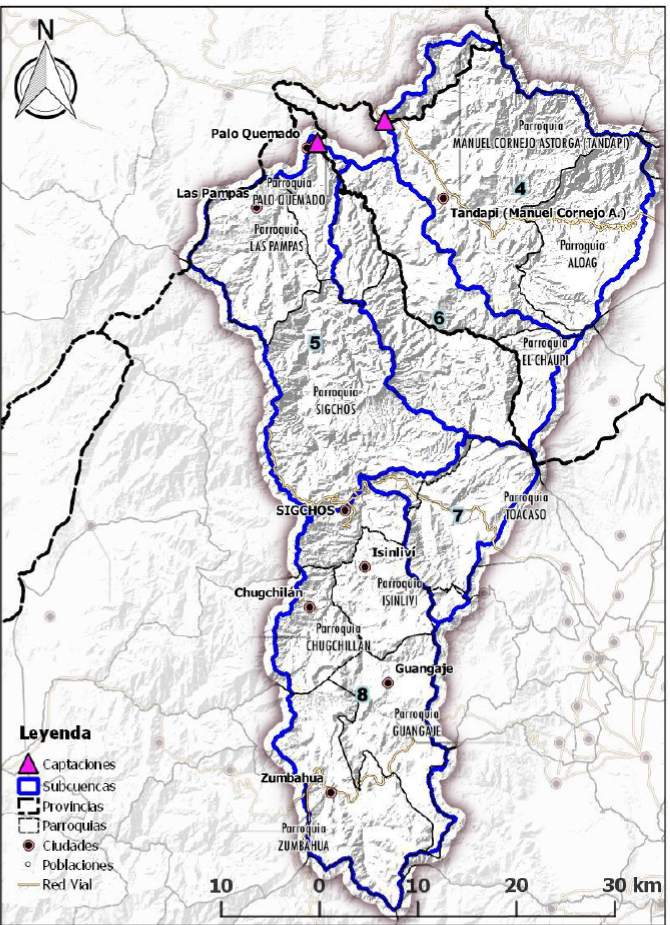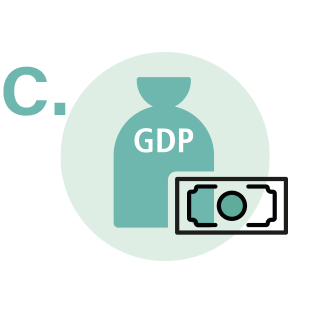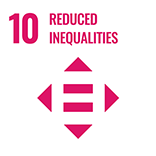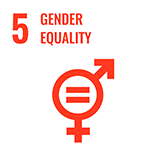Increasing the adaptive capacity of local communities, ecosystems and hydroelectric systems in the Río Blanco upper watershed with a focus on Ecosystem and Community Based Adaptation and Integrated Adaptive Watershed Management.

Summary
Implemented at the Rio Blanco upper watershed in Ecuador, this solution has the objective to strengthen the adaptive capacity of vulnerable local populations, ecosystems and hydroelectric systems, and to develop a model of adaptation to climate change that can be replicated in other areas of the country and the Andean region.
The Toachi-Pilatón water system, as the upper part of the Rio Blanco watershed is also known, consists of a 2,150 km2 drainage basin that originates in the western part of the Andes mountain range and flows down to the confluence in the Blanco River. This system is of fundamental importance for the well-being and development of the provinces of Cotopaxi, Pichincha, and Santo Domingo de los Tsachilas located within the drainage units and for the more than 74,000 local habitants who depend on water resources for agricultural, energy, livestock, and human consumption purposes. However, due to current and future climate change, the provision of these benefits is expected to be greatly affected by an expected reduction in water supply.
This project thus seeks to address the main barriers that could limit adaptation to climate change in the region by developing adaptation actions that enhance the resilience of communities. It aims to develop, test and implement solutions from a community and ecosystem-based approach.
The project consists of three core components:
- Component 1: Conservation of vegetation cover over an area of 230,000 ha, supported by the introduction of the active sustainable forest management and conservation technologies
- Component 2: Adaptation of farming practices to new climate change conditions and enable their climate smart financing
- Component 3: Strengthening of local capacities and share lessons
Overview
- Location:
- Implementation sites:
- Single country
- Single location
- Mountain region:
- The Andes
- Province:
- Cotopaxi, Pichincha, and Santo Domingo de los Tsachilas
- Site locations:
Toachi-Pilatón watershed
- Solution scale:
- Ecosystem type(s):
- Solution type(s):
- Sector(s):
- Climate impact(s) addressed:
- Impact time-scales:
- Co-benefits:
- Implementation timeline:
- 2020 - 2024
Solution details
Main beneficiaries & outcomes
The beneficiaries of this solution are approximated as 74,000 people located in the project implementation region, as well as other participants. More specifically, the project differentiates between direct co-executors, defined as those residents, organizations or institutions that will receive a transfer of resources or technology from the project’s funds, and indirect co-executors who will participate in the project’s activities without directly receiving project funds. In addition, the solution also targets other key actors in the communities that are able to generate multiplier effects with positive impact on the full community and the ecosystems, including technical, providers, agronomists, private and public institutions, and more.
Expected outcomes are:
- At least 230,000 ha of native vegetation is conserved to reduce the impact of climate change on the hydrological cycle under integrated watershed management.
- Sustainable farming practices and livestock adjusted to local realities are being introduced and implemented with assistance of financing mechanisms for adaptation measures.
- At least 1 long term financing mechanisms has been piloted or introduced.
- Local population and parish governments with increased capacity to implement climate change adaptation measures.
Special attention will be given to the participation and benefit of women, elderly, and other groups considered as highly vulnerable.
Planning and implementation
This project is implemented by the Development Bank of Latin America (CAF), and executed by the Food and Agriculture Organization (FAO) and the Ministry of Environment of Ecuador (MoE). These two agencies work in close coordination to guide the implementation of the solutions. FAO is the responsible entity for providing technical assistance and guidance in accordance to the project’s plan and budget, as well as for monitoring and evaluation activities, while the MoE is in charge of supplying political and strategic orientation, and leading the governance and decision-making process within the Project Steering Committee and Technical Committee.
With the objective of promoting ecosystem- and community-based adaptation, the project aims to develop multi-stakeholder coordination and implementation mechanisms. Participants include various national ministries, local and municipal governments, the Ministry of Agriculture and Livestock (MAG), the National Meteorological and Hydrological Institute (INAMHI), the Water Secretariat (SENAGUA), the Electric Corporation of Ecuador (CELEC), as well as local communities and associations, each of them engaged in distinct activities of the planning and implementation phases of the different project’s components.
The project’s implementation activities initiated in January 2020 and are expected to continue until January 2024 when the solution is due to close.
Finance
This project is financed by the Adaptation Fund under the request of the Development Bank of Latin America (CAF). The next table illustrates detailed information regarding the estimated costs of each of the components and the total project cost.
|
Project Component 1: Conservation of vegetation cover |
US$ 950,000 |
|
Project Component 2: Adaptation of farming practices to new climate change conditions and enable their climate smart financing |
US$ 840,000 |
|
Project Component 3: Strengthen local capacities and share lessons |
US$ 400,000 |
|
Project Execution Cost |
US$ 114,975 |
|
Total Project Cost |
US$ 2,304,975 |
|
Project Cycle Management Fee |
US$ 184,398 |
|
Grant Amount |
USD 2,489,373 |
Source: Adaptation Fund, 2021.
Cost-effectiveness analyses were conducted for both Components 1 and 2 (separately) for a 10 years’ time horizon and by taking into account initial investment and maintenance costs at a net present value (NPV), as well as the economic benefits at NPV and an internal return rate.
Innovation
Through the different proposed solutions, the project looks to promote, for example, the trial or partial introduction (on a minor part of the farmer`s plot) of innovative adaptation solutions that can allow farmers to limit their investment while observing concrete benefits and reducing the pressures on native forests and other resources. For example, with the Areas of Conservation and Sustainable Use (ACUS) approach, various alternative innovative technologies and equipment such as efficient sugar mills and ovens will be presented.
Innovative financing mechanisms are also planned to be used to assist the introduction and implementation of sustainable farming practices in accordance with local realities.
Performance evaluation
To assess the performance of the project, a Monitoring and Evaluation Plan has been developed and budgeted at USD 100,000. This will integrate the measurement of adaptive capacity via established indicators that will be developed from similar regional and national approaches (e.g. the National Adaptation Plan and current projects in Ecuador), and must comply with standard CAF requirements. Annual Adaptation Fund Project Performance Reports that include the Adaptation Fund Results Tracker will be prepared, as well as other regular monitoring activities implemented by FAO for supporting project-level adaptive management.
Monitoring activities will include: day-to-day monitoring, project progress supervision missions, technical monitoring of project indicators, specific monitoring plans for implementation of good practices, mid-term and final evaluations (independent consultants and CAF Evaluation Office), and monitoring and supervision missions (MAE, FAO and FAO). Some gender-sensitive indicators have also been proposed for incorporation.
Long term project sustainability and maintenance
In the design of the project, the sustainability of the project’s outcomes has been taken into account and analysed from three different perspectives: environmental, social, and economic sustainability. For each of the different project components the sustainability of actions is planned based on three criteria: 1) concordance with the regulatory framework; 2) availability of resources and economic criteria; and 3) communities’ empowerment.
During the implementation of the project, monthly reports of the technicians, forms of progress records, and attendance record in workshops and trainings are proposed as monitoring and evaluation instruments with different stakeholders being responsible for the maintenance of solutions. Meanwhile, for the long-term, at least one investment fund to promote sustainable development is planned to be built for integrating contributions from public and private stakeholders and ensure future management.
Capacities for design and implementation
Knowledge
Knowledge plays an important role in the project, as a lack of climate-related information was identified from the initial stages as one of the main barriers that may limit adaptation. In this case, the project aims to address this issue through
- The generation and dissemination of hydro meteorological information by improving and expanding the hydro meteorological network of the National Institute of Meteorology and Hydrology (INAMHI).
- Disseminating best adaptation practices through appropriate training/workshops for knowledge/skills development.
- Institutional learning
- Dissemination of best practices through education and knowledge transfer.
- Dissemination of project lessons learned through knowledge management platforms.
Scientific data will be used to support individual cost-effectiveness analysis of selected interventions, and to support the limited availability of academic studies with respect to the actual impact of ecosystem-based approaches for periodic reviews for monitoring and evaluation. A combination of local knowledge and adaptation practices with international best practices and methodologies will also be employed.
Technology
Available technologies are relevant to the implementation of this project since their use will be promoted under the “Best Available Technology” (BAT) approach for the achievement of more sustainable and efficient agricultural practices that adapt to the new climate change conditions. It is planned to seek the development or expansion of climate-resilient technologies for, e.g., improved water use or access to water, energy efficiency, solar energy capacity, biogas, water purification and solar salt production.
In addition, new or improved tools and technologies will be put in place to communicate weather and climate risks, and to monitor changes in the climate system. A technology platform (such as cloud computing and Big Data) will be developed to ensure the systematic storage and dissemination of a large amount of data, information, lessons learned and best practices implemented by the project.
Political / Legal
The execution of this project is consistent with national sustainable development strategies. It is for example aligned with current the national environment regulation contained in the Constitution of the Republic of Ecuador (2008) and which contains two articles related to climate change management in the country. Moreover, it is also in accordance with the National Development Plan, the Policy 3 of the Ministry of the environment of Ecuador, the National Law on Water Resources, Uses and Exploitation 2014, the National Climate Change Strategy (MAE, 2012), the Organic Code of the Environment (COA), and the National Adaptation Plan.
There exists a clear support from authorities for the implementation of this solution. The Ministry of Environment, as executing entity, is in charge of providing the political and strategic orientation and leading the governance and decision-making process.
Institutional
The close collaboration between project and local partners was facilitated by the creation of the following working teams:
- Steering Committee: In charge of project coordination and decision-making. It will meet semi-annually for approving the Annual Work plan and Procurement Plans, technical and financial progress reports, project deliverables, as well as to authorize any budget modification.
- Technical committee: Responsible for the technical and operational coordination.
- Project Management Unit: Responsible for the coordination of activities with the designed technical focal points to support activities.
The signing of complementary collaboration agreements with the Cotopaxi and Pichincha provincial governments, HIDROTOAPI and relevant local organizations is planned.
Socio-cultural
As part of the project, a stakeholder analysis was prepared to identify key stakeholders and existing or potential conflicts that could affect project implementation. This analysis served both to determine that there was no obvious opposition or conflicts, and to note the existence of strong female leadership in local organizations and parish governments.
In the implementation of activities, local farmers and their communities are not only key targets, but also play an important role as co-implementers of solutions. In the long term, it is intended that they will become active participants and lead the conservation process.
Outlook & Scalability
Barriers and adverse effects
Information on barriers or challenges during the implementation of solutions is not yet available, as the project is at an early stage. However, the design phase identified the following as the main barriers limiting adaptation in the lower basin of the Rio Blanco water system: the local population is not fully aware of climate-related impacts, local development plans do not incorporate adaptation measures, and local production is based on extensive agricultural practices. In this case, different actions have already been proposed to address each of these barriers.
The Project Unit will also identify the potential environmental and social risks of each of the activities foreseen in the project and design and program the corresponding mitigation measures.
Transformation and future outlook
This project aims to support climate adaptation in these mountainous areas through the conservation of ecosystems and by leveraging local knowledge and the involvement of local communities. In the long term, the different solutions implemented are intended to help strengthen the knowledge and adaptive capacities of local communities and stakeholders, thus reducing the level of future impacts that climate change may generate.
Potential for upscaling and replication
The climate adaptation model developed in the upper Rio Blanco watershed as well as the tested solutions are expected to be replicated in the future in other similar contexts at other locations and with other financial institutions. Under Component 3, local exchanges and cross-learning, systematization, development of tailor-made products, and understanding of opportunities for replication and scaling up will be encouraged. The learning generated will therefore be structured in a way that facilitates such activities.
Finally
Acknowledgments
The description of this solution was prepared based on the official project description and project proposal documents published by the Adaptation Fund through its official website and available at https://www.adaptation-fund.org/project/increasing-adaptive-capacity-local-communities-ecosystems-hydroelectric-systems-rio-blanco-upper-watershed-toachi-pilaton-watershed/. The solution description reflects the views of the authors and not those of the Adaptation Fund, the Government of Ecuador or any other project partner. Julia Aguilera Rodriguez was responsible for completing the survey information, while Simon Allen reviewed the solution description.
Key references/links
Adaptation Fund Board. (2020). PROJECT/PROGRAMME PROPOSAL TO THE ADAPTATION FUND. Retrieved from Adaptation Fund: https://www.adaptation-fund.org/projects-document-view/?URL=en/932531600094152829/1415-Intersessional-Decision-AFB-B-35-a-35-b37-Ecuador-CAF.pdf









(0) Comments
There is no content